(AKC Terrier Group)
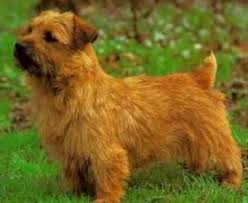 One of the smallest working terriers, the Norfolk Terrier is active,
compact and hardy, considered to be the "perfect demon" in the field.
Farmers and hunters admire the breed’s gameness, loyalty and great
charm. Known for his drop ears, the Norfolk Terrier has a wiry, weather
resistant coat that can be red, wheaten, black and tan or grizzle.
One of the smallest working terriers, the Norfolk Terrier is active,
compact and hardy, considered to be the "perfect demon" in the field.
Farmers and hunters admire the breed’s gameness, loyalty and great
charm. Known for his drop ears, the Norfolk Terrier has a wiry, weather
resistant coat that can be red, wheaten, black and tan or grizzle.
General Appearance
The Norfolk Terrier, game and hardy, with expressive dropped ears, is one of the smallest of the working terriers. It is active and compact, free-moving, with good substance and bone. With its natural, weather-resistant coat and short legs, it is a "perfect demon" in the field. This versatile, agreeable breed can go to ground, bolt a fox and tackle or dispatch other small vermin, working alone or with a pack. Honorable scars from wear and tear are acceptable in the ring.
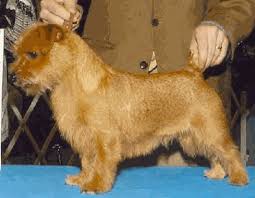 Size, Proportion, Substance
Size, Proportion, Substance
Height at the withers 9 to 10 inches at maturity. Bitches tend to be smaller than dogs. Length of back from point of withers to base of tail should be slightly longer than the height at the withers. Good substance and bone. Weight 11 to 12 pounds or that which is suitable for each individual dog's structure and balance. Fit working condition is a prime consideration.
Head
Eyes small, dark and oval, with black rims. Placed well apart with a sparkling, keen and intelligent expression. Ears neatly dropped, small, with a break at the skull line, carried close to the cheek and not falling lower than the outer corner of the eye. V-shaped, slightly rounded at the tip, smooth and velvety to the touch. Skull wide, slightly rounded, with good width between the ears. Muzzle is strong and wedge shaped. Its length is one-third less than a measurement from the occiput to the well-defined stop. Jaw clean and strong. Tight-lipped with a scissor bite and large teeth.
Neck, Topline, Body
Neck of medium length, strong and blending into well laid back shoulders. Level topline. Good width of chest. Ribs well sprung, chest moderately deep. Strong loins. Tail medium docked, of sufficient length to ensure a balanced outline. Straight, set on high, the base level with the topline. Not a squirrel tail.
Forequarters
Well laid back shoulders. Elbows close to ribs. Short, powerful legs, as straight as is consistent with the digging terrier. Pasterns firm. Feet round, pads thick, with strong, black nails.
Hindquarters
Broad with strong, muscular thighs. Good turn of stifle. Hocks well let down and straight when viewed from the rear. Feet as in front.
Coat
The protective coat is hard, wiry and straight, about 1½ to 2 inches long, lying close to the body, with a definite undercoat. The mane on neck and shoulders is longer and also forms a ruff at the base of the ears and the throat. Moderate furnishings of harsh texture on legs. Hair on the head and ears is short and smooth, except for slight eyebrows and whiskers. Some tidying is necessary to keep the dog neat, but shaping should be heavily penalized.
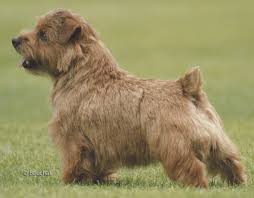 Color
Color
All shades of red, wheaten, black and tan, or grizzle. Dark points permissible. White marks are not desirable.
Gait
Should be true, low and driving. In front, the legs extend forward from the shoulder. Good rear angulation showing great powers of propulsion. Viewed from the side, hind legs follow in the track of the forelegs, moving smoothly from the hip and flexing well at the stifle and hock. Topline remains level.
Approved October 13, 1981
Reformatted March 23, 1990
The life expectancy of a Norfolk Terrier is 12–15 years, with some growing as old as 19 years. Norfolks do have incidences of mitral valve disease, luxating patellas, and incorrect bites (where the teeth do not align with the breed standard, i.e. overshot or undershot). Norfolks most often have shallow hip sockets and many breedlines are dysplastic. There has never been a Norfolk Terrier recognized by the Orthopedic Foundation for Animals (OFA) as having "excellent" rated hips. Therefore responsible breeders are testing for hip dysplasia. Breeders that do not radiograph hips and have them evaluated by either OFA or PennHip, cannot answer questions regarding hip dysplasia in their breeding program.
 Norfolks generally have medium to small litters. Responsible breeders
only breed healthy dogs who are of good temperament, good pedigree
lineage and best reflect the breed standard. The demand for Norfolk is
far greater than the supply. The environment in which they are raised
directly impacts the temperament of the puppy for its lifetime.
Norfolks generally have medium to small litters. Responsible breeders
only breed healthy dogs who are of good temperament, good pedigree
lineage and best reflect the breed standard. The demand for Norfolk is
far greater than the supply. The environment in which they are raised
directly impacts the temperament of the puppy for its lifetime.
Norfolks are described as fearless, but can be aggressive. They, along with Norwich Terriers and Border Terriers, have the softest temperaments of the Terrier Group. Norfolks work in packs and must get along with other dogs.
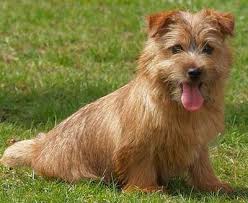 As companions, they love people and children and do make good pets.
Their activity level is generally reflective of the pace of their
environment. This breed should not be kept or live outside since they
thrive on human contact. Generally, Norfolks are not given to digging
but, like any dog, will dig out of boredom when left alone for too long a
period. Norfolks can be barkers and are very vocal. They generally
cohabit well with other household pets when introduced as a puppy.
Outdoors, they are natural hunters with a strong prey drive for small
vermin.
As companions, they love people and children and do make good pets.
Their activity level is generally reflective of the pace of their
environment. This breed should not be kept or live outside since they
thrive on human contact. Generally, Norfolks are not given to digging
but, like any dog, will dig out of boredom when left alone for too long a
period. Norfolks can be barkers and are very vocal. They generally
cohabit well with other household pets when introduced as a puppy.
Outdoors, they are natural hunters with a strong prey drive for small
vermin.
Norfolks are self confident and carry themselves with presence and importance, holding their heads and tails erect. A Norfolk that is shy or that carries its tail between its legs is atypical, as is a dog that is hot tempered and aggressive with other dogs; these traits are not the standard. A Norfolk's typical temperament is happy, spirited, and self confident.
The Norfolk Terrier is small and sturdy, alert and fearless, with sporting instincts and an even temperament. Good natured and gregarious, the Norfolk has proved adaptable under a wide variety of conditions.
In England at the turn of the century, working terriers from stables in Cambridge, Market Harborough, and Norwich, were used by Frank "Roughrider" Jones to develop a breed recognized by the English Kennel Club in 1932 as the Norwich Terrier. In the early days there was a diversity in type, size, color, coat, and ear carriage. Correct color and ear carriage were constantly argued. When the Norwich breed standard was drawn up the drop ear and the prick ear terriers remained one breed. The English Kennel Club, in 1964, recognized them as two breeds-the drop ear variety as the Norfolk and the prick ear as the Norwich.
 In the United States those who remember the "Roaring Twenties" still
refer to the Norwich as a "Jones Terrier" after Frank Jones, from whom
many American sportsmen traveling abroad bought their first little red
terriers. In 1936, thanks to the efforts of Gordon Massey (who
registered the first Norwich Terrier in this country) and Henry Bixby,
then Executive Vice President of the American Kennel Club, the Norwich
Terrier was accepted as a breed by the AKC. It remained one breed until
1979 when division by ear carriage became official. The drop ears are
now recognized as the Norfolk, while the prick ears remain Norwich.
In the United States those who remember the "Roaring Twenties" still
refer to the Norwich as a "Jones Terrier" after Frank Jones, from whom
many American sportsmen traveling abroad bought their first little red
terriers. In 1936, thanks to the efforts of Gordon Massey (who
registered the first Norwich Terrier in this country) and Henry Bixby,
then Executive Vice President of the American Kennel Club, the Norwich
Terrier was accepted as a breed by the AKC. It remained one breed until
1979 when division by ear carriage became official. The drop ears are
now recognized as the Norfolk, while the prick ears remain Norwich.
Visually there appears to be a distinct difference between the two breeds, resulting in two slightly different breed standards. Each breed has developed with success since separation.
Today, although as many live in cities as in foxhunting country, the Norfolk should still conform to the standard. The characteristic coat requires regular grooming but trimming is heavily penalized. The ears should be neatly dropped, slightly rounded at the tip, carried close to the cheek and not falling lower than the outer corner of the eye.
The Norfolk Terrier is essentially a sporting terrier-not a toy. His chief attributes are gameness, hardiness, loyalty to his master, and great charm. He is affectionate and reasonably obedient. He must be kept small enough to conform with the standard. Above all, the outstanding personality, characteristic of the breed, must never be subordinated for the sake of appearance and conformation.
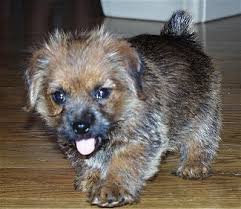
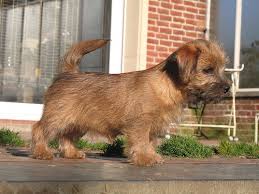
Norfolk Terrier AKC Breed Standards
General Appearance
The Norfolk Terrier, game and hardy, with expressive dropped ears, is one of the smallest of the working terriers. It is active and compact, free-moving, with good substance and bone. With its natural, weather-resistant coat and short legs, it is a "perfect demon" in the field. This versatile, agreeable breed can go to ground, bolt a fox and tackle or dispatch other small vermin, working alone or with a pack. Honorable scars from wear and tear are acceptable in the ring.
Height at the withers 9 to 10 inches at maturity. Bitches tend to be smaller than dogs. Length of back from point of withers to base of tail should be slightly longer than the height at the withers. Good substance and bone. Weight 11 to 12 pounds or that which is suitable for each individual dog's structure and balance. Fit working condition is a prime consideration.
Head
Eyes small, dark and oval, with black rims. Placed well apart with a sparkling, keen and intelligent expression. Ears neatly dropped, small, with a break at the skull line, carried close to the cheek and not falling lower than the outer corner of the eye. V-shaped, slightly rounded at the tip, smooth and velvety to the touch. Skull wide, slightly rounded, with good width between the ears. Muzzle is strong and wedge shaped. Its length is one-third less than a measurement from the occiput to the well-defined stop. Jaw clean and strong. Tight-lipped with a scissor bite and large teeth.
Neck, Topline, Body
Neck of medium length, strong and blending into well laid back shoulders. Level topline. Good width of chest. Ribs well sprung, chest moderately deep. Strong loins. Tail medium docked, of sufficient length to ensure a balanced outline. Straight, set on high, the base level with the topline. Not a squirrel tail.
Forequarters
Well laid back shoulders. Elbows close to ribs. Short, powerful legs, as straight as is consistent with the digging terrier. Pasterns firm. Feet round, pads thick, with strong, black nails.
Hindquarters
Broad with strong, muscular thighs. Good turn of stifle. Hocks well let down and straight when viewed from the rear. Feet as in front.
Coat
The protective coat is hard, wiry and straight, about 1½ to 2 inches long, lying close to the body, with a definite undercoat. The mane on neck and shoulders is longer and also forms a ruff at the base of the ears and the throat. Moderate furnishings of harsh texture on legs. Hair on the head and ears is short and smooth, except for slight eyebrows and whiskers. Some tidying is necessary to keep the dog neat, but shaping should be heavily penalized.
All shades of red, wheaten, black and tan, or grizzle. Dark points permissible. White marks are not desirable.
Gait
Should be true, low and driving. In front, the legs extend forward from the shoulder. Good rear angulation showing great powers of propulsion. Viewed from the side, hind legs follow in the track of the forelegs, moving smoothly from the hip and flexing well at the stifle and hock. Topline remains level.
Approved October 13, 1981
Reformatted March 23, 1990
Norfolk Terrier Health Issues
The life expectancy of a Norfolk Terrier is 12–15 years, with some growing as old as 19 years. Norfolks do have incidences of mitral valve disease, luxating patellas, and incorrect bites (where the teeth do not align with the breed standard, i.e. overshot or undershot). Norfolks most often have shallow hip sockets and many breedlines are dysplastic. There has never been a Norfolk Terrier recognized by the Orthopedic Foundation for Animals (OFA) as having "excellent" rated hips. Therefore responsible breeders are testing for hip dysplasia. Breeders that do not radiograph hips and have them evaluated by either OFA or PennHip, cannot answer questions regarding hip dysplasia in their breeding program.
Norfolk Terrier Temperament
Norfolks are described as fearless, but can be aggressive. They, along with Norwich Terriers and Border Terriers, have the softest temperaments of the Terrier Group. Norfolks work in packs and must get along with other dogs.
Norfolks are self confident and carry themselves with presence and importance, holding their heads and tails erect. A Norfolk that is shy or that carries its tail between its legs is atypical, as is a dog that is hot tempered and aggressive with other dogs; these traits are not the standard. A Norfolk's typical temperament is happy, spirited, and self confident.
Did You Know?
- The Norfolk Terrier is a small, sturdy, alert, and fearless dog with sporting instincts and an even temperament.
- The Norfolk Terrier is a game and hardy little dog originally bred to go to ground after vermin and catch a fox.
- The Norfolk Terrier has drop ears.
- Prior to 1979 the Norfolk Terrier was known as the Norwich Terrier with drop ears. In 1979, it became a separate breed and known as the Norfolk Terrier.
- Although Norfolk and Norwich Terriers share the same ancestry, there has been little interbreeding of ear types since ring competition resumed after World War II.
- In America the terrier authority William Ross Proctor suggested separate classes for each ear type in 1962; and this division was used in American Club sponsored shows and matches until 1979.
Norfolk Terrier History
The Norfolk Terrier is small and sturdy, alert and fearless, with sporting instincts and an even temperament. Good natured and gregarious, the Norfolk has proved adaptable under a wide variety of conditions.
In England at the turn of the century, working terriers from stables in Cambridge, Market Harborough, and Norwich, were used by Frank "Roughrider" Jones to develop a breed recognized by the English Kennel Club in 1932 as the Norwich Terrier. In the early days there was a diversity in type, size, color, coat, and ear carriage. Correct color and ear carriage were constantly argued. When the Norwich breed standard was drawn up the drop ear and the prick ear terriers remained one breed. The English Kennel Club, in 1964, recognized them as two breeds-the drop ear variety as the Norfolk and the prick ear as the Norwich.
Visually there appears to be a distinct difference between the two breeds, resulting in two slightly different breed standards. Each breed has developed with success since separation.
Today, although as many live in cities as in foxhunting country, the Norfolk should still conform to the standard. The characteristic coat requires regular grooming but trimming is heavily penalized. The ears should be neatly dropped, slightly rounded at the tip, carried close to the cheek and not falling lower than the outer corner of the eye.
The Norfolk Terrier is essentially a sporting terrier-not a toy. His chief attributes are gameness, hardiness, loyalty to his master, and great charm. He is affectionate and reasonably obedient. He must be kept small enough to conform with the standard. Above all, the outstanding personality, characteristic of the breed, must never be subordinated for the sake of appearance and conformation.
Norfolk Terrier Pics
AKC Registered Breeders
Nofolk Terrier
Parent Club: Norfolk Terrier Club
Parent Club: Norfolk Terrier Club
No comments:
Post a Comment